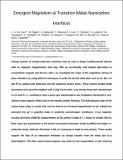Files in this item
Emergent magnetism at transition-metal–nanocarbon interfaces
Item metadata
| dc.contributor.author | Al Ma’Mari, Fatma | |
| dc.contributor.author | Rogers, Matthew | |
| dc.contributor.author | Alghamdi, Shoug | |
| dc.contributor.author | Moorsom, Timothy | |
| dc.contributor.author | Lee, Stephen Leslie | |
| dc.contributor.author | Prokscha, Thomas | |
| dc.contributor.author | Luetkens, Hubertus | |
| dc.contributor.author | Valvidare, Manuel | |
| dc.contributor.author | Teobaldi, Gilberto | |
| dc.contributor.author | Flokstra, Machiel Geert | |
| dc.contributor.author | Stewart, Rhea | |
| dc.contributor.author | Gargiani, Pierluigi | |
| dc.contributor.author | Ali, Mannan | |
| dc.contributor.author | Burnell, Gavin | |
| dc.contributor.author | Hickey, B. J. | |
| dc.contributor.author | Cespedes, Oscar | |
| dc.date.accessioned | 2017-11-16T00:33:17Z | |
| dc.date.available | 2017-11-16T00:33:17Z | |
| dc.date.issued | 2017-05-30 | |
| dc.identifier | 250129301 | |
| dc.identifier | 76c39b54-d902-4855-a731-a6b4916ac66f | |
| dc.identifier | 85020047292 | |
| dc.identifier | 000402296700035 | |
| dc.identifier.citation | Al Ma’Mari , F , Rogers , M , Alghamdi , S , Moorsom , T , Lee , S L , Prokscha , T , Luetkens , H , Valvidare , M , Teobaldi , G , Flokstra , M G , Stewart , R , Gargiani , P , Ali , M , Burnell , G , Hickey , B J & Cespedes , O 2017 , ' Emergent magnetism at transition-metal–nanocarbon interfaces ' , Proceedings of the National Academy of Sciences of the United States of America , vol. 114 , no. 22 , pp. 5583-5588 . https://doi.org/10.1073/pnas.1620216114 | en |
| dc.identifier.issn | 0027-8424 | |
| dc.identifier.other | ORCID: /0000-0002-2020-3310/work/54995359 | |
| dc.identifier.other | ORCID: /0000-0002-4333-1358/work/59953700 | |
| dc.identifier.uri | https://hdl.handle.net/10023/12108 | |
| dc.description | We thank the Engineering and Physical Sciences Research Council (EPSRC) in the United Kingdom for support through Grants EP/P001556/1, EP/J01060X/1, EP/I004483/1, and EP/M000923/1. R.S. wishes to acknowledge EPSRC for a scholarship via the Grant EP/L015110/1. XAS/XMCD experiments were performed in the BOREAS beamline at the Alba synchrotron (Proposals ID2014071101 and ID2015091530). M.V. acknowledges Mineco Grant FIS2013-45469-C4-3-R. Use of the N8 High Performance Computing (HPC) (EPSRC EP/K000225/1) and ARCHER (via the UK Car–Parrinello Consortium, EP/K013610/1 and EP/P022189/1) | en |
| dc.description.abstract | Charge transfer at metallo–molecular interfaces may be used to design multifunctional hybrids with an emergent magnetization that may offer an eco-friendly and tunable alternative to conventional magnets and devices. Here, we investigate the origin of the magnetism arising at these interfaces by using different techniques to probe 3d and 5d metal films such as Sc, Mn, Cu, and Pt in contact with fullerenes and rf-sputtered carbon layers. These systems exhibit small anisotropy and coercivity together with a high Curie point. Low-energy muon spin spectroscopy in Cu and Sc–C60 multilayers show a quick spin depolarization and oscillations attributed to nonuniform local magnetic fields close to the metallo–carbon interface. The hybridization state of the carbon layers plays a crucial role, and we observe an increased magnetization as sp3 orbitals are annealed into sp2−π graphitic states in sputtered carbon/copper multilayers. X-ray magnetic circular dichroism (XMCD) measurements at the carbon K edge of C60 layers in contact with Sc films show spin polarization in the lowest unoccupied molecular orbital (LUMO) and higher π*-molecular levels, whereas the dichroism in the σ*-resonances is small or nonexistent. These results support the idea of an interaction mediated via charge transfer from the metal and dz–π hybridization. Thin-film carbon-based magnets may allow for the manipulation of spin ordering at metallic surfaces using electrooptical signals, with potential applications in computing, sensors, and other multifunctional magnetic devices. | |
| dc.format.extent | 6 | |
| dc.format.extent | 2380563 | |
| dc.language.iso | eng | |
| dc.relation.ispartof | Proceedings of the National Academy of Sciences of the United States of America | en |
| dc.subject | Emergent magnetism | en |
| dc.subject | Molecular spintronics | en |
| dc.subject | Interfacial magnetism | en |
| dc.subject | Charge transfer | en |
| dc.subject | Nanocarbon | en |
| dc.subject | QC Physics | en |
| dc.subject | T Technology | en |
| dc.subject | DAS | en |
| dc.subject.lcc | QC | en |
| dc.subject.lcc | T | en |
| dc.title | Emergent magnetism at transition-metal–nanocarbon interfaces | en |
| dc.type | Journal article | en |
| dc.contributor.sponsor | EPSRC | en |
| dc.contributor.sponsor | EPSRC | en |
| dc.contributor.sponsor | EPSRC | en |
| dc.contributor.institution | University of St Andrews. School of Physics and Astronomy | en |
| dc.contributor.institution | University of St Andrews. Condensed Matter Physics | en |
| dc.identifier.doi | https://doi.org/10.1073/pnas.1620216114 | |
| dc.description.status | Peer reviewed | en |
| dc.date.embargoedUntil | 2017-11-15 | |
| dc.identifier.grantnumber | EP/I031014/1 | en |
| dc.identifier.grantnumber | EP/J01060X/1 | en |
| dc.identifier.grantnumber | EP/L015110/1 | en |
This item appears in the following Collection(s)
Items in the St Andrews Research Repository are protected by copyright, with all rights reserved, unless otherwise indicated.

